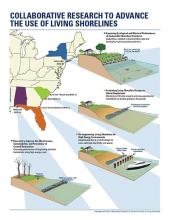
Nature-based, ecologically enhanced, soft, or living shoreline techniques are increasingly being used to stabilize shorelines.
Coastal communities and their shorelines are increasingly vulnerable to the impacts of climate change. A variety of living shoreline techniques have been shown to reduce erosion and stabilize shorelines while protecting habitat. However, these nature-based shoreline approaches are not adopted as widely as they could be. Through collaborative science projects, a number of researchers working closely with National Estuarine Research Reserve System have addressed key information needs identified by landowners, regulators, and contractors, including questions about living shoreline placement, design, and long-term performance.
About this collection
This collection features living shorelines work completed by project teams from 2015-2019. The projects in this collection sought to address questions about living shoreline placement, design, and long-term performance, as well as develop tools, such as guidance for site assessments and post-installation monitoring, to ease the burden of getting living shorelines into practice.
Collection resources
Panel Webinar: Session Recording | Webinar Summary Report
Representatives from the projects featured in this brief participated in a panel webinar on April 11, 2019 to discuss lessons learned and next steps, opportunities, and needs for living shorelines management and research.
Management Brief and Infographic: Collaborative Research to Advance the Use of Living Shorelines (PDF)
This management brief highlights the work of four teams, supported in part by the NERRS Science Collaborative, that have worked on living shoreline issues in New York, South Carolina, eastern Florida, and the Alabama Gulf Coast. The infographic illustrates different shoreline stabilization strategies and how they vary across locations in order to suit the conditions present.
This document was prepared by NERRS Science Collaborative staff, with input from Christine Angelini, Stuart Findlay, Jennifer Raulin, Denise Sanger, and Eric Sparks, and their project partners.